The Cornish Miner and Beyond
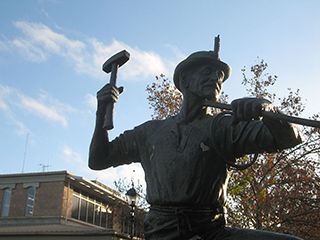
In my home town of Bendigo, back in Australia, there is a lovely memorial statue The Cornish Miner erected in appreciation of the efforts of all the underground miners of Bendigo and District. Cornishmen and their descendants formed the majority of these miners. The statue was made by Ruth Lyon. Many of my ancestoral family were miners in Cornwall and continued this practice in their new home of Australia. Their endeavours made Bendigo and Ballarat amongst the richest goldfields in the world. This wealth built these two tent towns into flourishing modern cities, both of which established Art Galleries very early in their history and continue today as premier country cultural centres. Jane and Caroline have been bringing you the latest from the Ballarat Art Gallery and there is more to come in a couple of days.
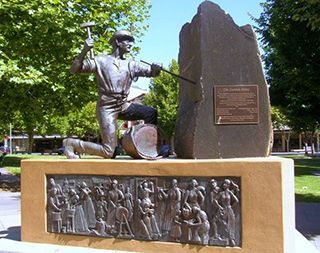
Mining in Cornwall and Devon, in the southwest of England, began in the early Bronze Age, around 2150 BC, and ended (at least temporarily) with the closure of South Crofty tin mine in Cornwall in 1998. Tin, and later copper, were the most commonly extracted metals. Some tin mining continued long after the mining of other metals had become unprofitable. (Wikipedia)**



Historically, tin and copper as well as a few other metals (e.g. arsenic, silver, and zinc) have been mined in Cornwall and Devon. As of 2007 there are no active metalliferous mines remaining. However, tin deposits still exist in Cornwall, and there has been talk of reopening the South Crofty tin mine. In addition, work has begun on re-opening the Hemerdon tungsten and tin mine in south-west Devon. In view of the economic importance of mines and quarries, geological studies have been conducted; about forty distinct minerals have been identified from type localities in Cornwall (e.g. endellionite from St Endellion). Quarrying of the igneous and metamorphic rocks has also been a significant industry. In the 20th century the extraction of kaolin was important economically. (Wikipedia)
Seeing the poppet heads from the mines has made me a little homesick.
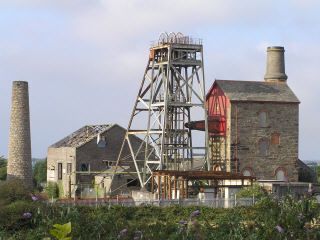
In 2013 Truro’s Royal Cornwall Museum was donated a historic oil painting of a 19th-century Cornish mining scene (on the left below). The painting shows a mine count-house, or office, where an auction of copper ore is taking place. A mixed group of buyers, miners and bal-maidens is depicted, along with the mine managers.... The painting bears a striking resemblance to another work also in the care of the museum, again anonymous, which is known simply as ‘A Cornish Mining Scene’. The latter bears the initials WP.
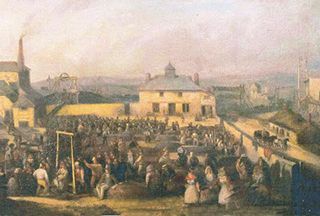
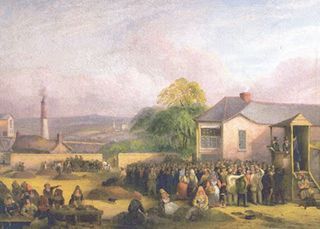
The Cornish Mining World Heritage Site, which promotes Cornwall’s mining legacy, has studied both paintings and found similarities. In each, bal-maidens attend to their daily work, many wearing the distinctive white Cornish ‘gook’, a form of protective headgear. As the sale of ore takes place, buyers cluster around the managers. Both paintings show piles or doles of copper, ready for selling, while background buildings and scenery are also alike.
The Heritage Site says the paintings reproduce many activities of a Cornish tin mine of the period; some are particularly accurate. The earlier painting shows a raised wooden trough carrying water from the mine engine house and shaft; such channels often leaked, and the painter includes this detail. Some of the bal-maidens are dressing the copper ore, while others bring the ore to the balance-scales for weighing, before it's auctioned.
But licence has also been used. In the later painting the maidens are dressing the ore close to the count house, unlikely in real life; this job was usually done at the mine workings, rather than near the offices. In the more recent painting, a thatched cottage is in close proximity to a smoking mine chimney. (http://petelondon.blogspot.com)
If you recognise the artist (perhaps a Cornish ancestor of yours) please contact the The Royal Cornwall Museum.
I will conclude today with some examples of the landscapes created by Cornish artist Gerry Hillman who lives high on the Cornish moors with his partner, Lois.
Moorland ponies, cattle and sheep graze up to the garden walls under the calls of buzzards and ravens in the wide sky above. All around the ruined engine houses and smokestacks of the Victorian copper and tin mines are now mostly overgrown and reclaimed by Nature and here and there are signs of bronze age settlements and early mineral workings. From summer sun to winter snow, it’s a rich, wild landscape for finding inspiration. (gerryhillman.co.uk)
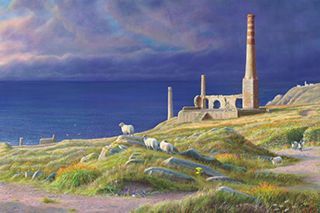
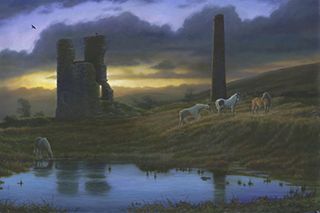
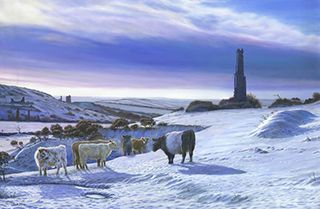
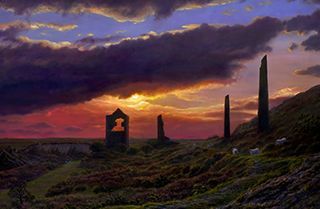
I highly recommend you take a look at the on-line gallery of Gerry Hillman to enjoy his perspective on Cornwall.
Much to my delight I visited Port Isaac which is also the fictional town of Port Wenn home to the TV series Doc Martin. Just a few images of this delightful Cornish village nestled on the side of a cliff overlooking the sea.






And then later in the day I was able to take in a local exhibition run by the Padstow Art Group. I love these community art groups, this one meets every Tuesday night. Check out the Padstow Art Group Home Page to meet the artists and see some of their paintings. I'm in contact with their Chairman Derek Lindsey and I will be showcasing some of their work very soon.
MAIL
From Julie of Melbourne
Thank you Anne, this is a great summary of Dartmoor! So many aspects to it,
isn’t there! No wonder you love it! So beautiful in its wildness and changing
conditions! Just gorgeous in the changing light conditions. Had to laugh about
the brown belted cattle! Maybe there was a “visitor” to the paddock at some
stage!! I also loved the Cathedral at Wells, beautiful symmetry and curves!
Unbelievable as to how they ever got built in the first place, with limited
tools so long ago, but the perfect dimensions and balance mean they stand the
test of time! Thank you for sharing your holiday with us!
Thank you Julie. As you say - so many aspects to Dartmoor. You could spend weeks there and only begin the touch the tip of this wonderland of colour, shape and atmosphere. And there is much more to tell about the symmetry of Wells Cathedral so watch this space.
